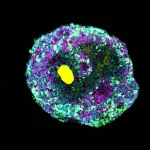(Press-News.org) New research from the University of East Anglia (UEA) found that more than a third of quitters who were given a vape in A&E experimented with different devices bought from shops or online
People who smoke and had little experience with vapes were particularly receptive to an opportunistic approach in a medical setting
The study found that some quitters reduced their vaping significantly within a few months, showing that not everyone who uses an e-cigarette becomes dependent on vaping long-term
Peer-reviewed – Observational Study- People
Experimenting with commercially available vapes may be important for some people’s success in giving up smoking, according to new research.
The University of East Anglia led a study which found that giving out free e-cigarette starter packs in hospital emergency departments to people who smoke helped one in four people quit.
The trial, which was funded by the National Institute for Health and Care Research (NIHR) and run by UEA’s Norwich Clinical Trials Unit, took place across six UK hospitals, and this latest research delves into the different ways people transitioned from smoking to vaping after receiving the e-cigarette smoking cessation intervention.
More than half of participants the research team managed to contact 6 months after their visit to the emergency department had quit or reduced smoking and a third of those who quit smoking were also not vaping.
Lead author Dr Emma Ward, from UEA’s Norwich Medical School, said: “There is a school of thought that vapes should only be available on prescription.
“However, our findings suggest that over a third of quitters, who were given a vape to help them quit by a healthcare professional, went on to experiment with different devices bought from shops or online.
“Some people managed to quit smoking soon after being given the vape, while others used both cigarettes and vapes for a period, taking longer than a month to quit.
“Satisfaction with vaping was important for success with quitting smoking, but personal motivation and being in a supportive environment were also significant factors.”
A total of 1,010 adult daily smokers were involved in the trial, with 505 receiving the free vapes in A&E.
Only intervention participants who responded at six months follow-up were included in the analysis for this latest study, resulting in a survey sample of 366 participants.
A total of 24 participants took part in interviews as part of the trial evaluation and were selected to represent the demographics of the main study sample.
The authors say the research highlights the effectiveness of opportunistic e-cigarette interventions, demonstrating multiple quitting pathways, showing that different people benefit in various ways.
Dr Ward added: “Some people quit smoking following the intervention without long-term e-cigarette use, while others benefited from longer-term use to avoid smoking relapse.
“Those less experienced with vaping may be particularly receptive to receiving opportunistic support in a medical setting.”
The findings support previous research conducted by Dr Ward, which showed that accessing vapes via the NHS might not be appealing to everyone, because some people do not see e-cigarettes as treatments but more as consumer products that they can shop for themselves.
‘How do people quit smoking using e-cigarettes? A mixed-methods exploration of participant smoking pathways following receiving an opportunistic e-cigarette based smoking cessation intervention’ is published in the journal Addiction.
As the research was only a trial, people who smoke are reminded that A&E departments are not currently handing out free vapes.
Help to stop smoking is available at https://www.nhs.uk/better-health/quit-smoking/
END
Experimenting with different vapes could be crucial to help people quit smoking
2024-09-10
ELSE PRESS RELEASES FROM THIS DATE:
Long-term exercisers have 'healthier' belly fat
2024-09-10
People with obesity who are long-time exercisers have healthier belly fat tissue and can store fat there more effectively than nonexercisers with obesity, according to a new study from a team of researchers at the University of Michigan.
The research team also grew fat tissue in the lab from cells collected from both exercisers and nonexercisers, and cells from the exercisers developed into a tissue that stored fat more effectively.
"Our findings indicate that in addition to being a means to expend calories, exercising regularly for several months to years seems to modify your fat tissue ...
Gene therapy effective in hereditary blindness
2024-09-10
Bothnia dystrophy is a form of hereditary blindness, prevalent in the region Västerbotten in Sweden. A new study at Karolinska Institutet published in Nature Communications shows that gene therapy can improve vision in patients with the disease.
Bothnia dystrophy occurs mainly in the region Västerbotten in Sweden, but the disease has also been identified in other parts of the world. The disease leads to progressive visual impairment due to the destruction of the visual cells in the retina. It is caused by an inherited genetic mutation ...
Report: Conscientiousness, not willpower, is a reliable predictor of success
2024-09-10
CHAMPAIGN, Ill. — According to two psychologists, the field of psychological science has a problem with the concept of self-control. It has named self-control both a “trait” — a key facet of personality involving attributes like conscientiousness, grit and the ability to tolerate delayed gratification — and a “state,” a fleeting condition that can best be described as willpower. These two concepts are at odds with one another and are often confused, the authors report.
“Self-control is a cherished quality. People who have lots of it are celebrated and seen as morally righteous,” wrote University of Toronto psychology professor Michael Inzlicht ...
Advancing prison safety
2024-09-10
The lead article in the current issue of The Criminologist, written by Nancy Rodriguez, University of California Irvine professor of criminology, law and society, shines a light on the lack of prison violence metrics that could help advance safety.
“For the 800,000 persons currently confined and the 200,000 state and federal correctional officers who work within U.S. prisons, the threat of violence is a routine feature of daily life,” she writes. “Accounts from incarcerated persons and staff detail the ever-present threats ...
Towards a better understanding of epigenetics and dynamic gene silencing and reactivation
2024-09-10
Ikoma, Japan – One of the most fascinating discoveries in biology is that cells have mechanisms for dynamically regulating genetic expression. This ability to promote or restrict the transcription of specific genes without altering the DNA sequences themselves is essential to all forms of life, from single-cell organisms to the most complex plants and animal species.
While our understanding of these so-called epigenetic mechanisms is far from complete, remarkable progress has been made in this field with the understanding of the role of the Polycomb Repressive Complex 2 (PRC2). PRC2 is a protein that, in many plants, binds to specific DNA sequences called polycomb ...
Artificial muscles propel a robotic leg to walk and jump
2024-09-09
Inventors and researchers have been developing robots for almost 70 years. To date, all the machines they have built – whether for factories or elsewhere – have had one thing in common: they are powered by motors, a technology that is already 200 years old. Even walking robots feature arms and legs that are powered by motors, not by muscles as in humans and animals. This in part suggests why they lack the mobility and adaptability of living creatures.
A new muscle-powered robotic leg is not only more energy efficient than a conventional one, it can also perform high jumps and fast movements as well as detect and react to obstacles – ...
Researchers develop reaction-induced molybdenum carbides for efficient carbon dioxide conversion
2024-09-09
Molybdenum (Mo) carbides, known for their unique electronic and structural properties, are considered promising alternatives to noble metal catalysts in heterogeneous catalysis. However, traditional methods for preparing Mo carbides suffer from complex processes, stringent synthesis conditions, challenging crystal regulation, and high energy consumption. Additionally, Mo carbides are susceptible to oxidation and deactivation, which poses a significant barrier to their widespread application.
In a study published in Nature Chemistry, a research group led by Prof. SUN Jian from the Dalian Institute ...
Researchers identify factor that drives prostate cancer-causing genes
2024-09-09
For more information, contact:
Nicole Fawcett, nfawcett@umich.edu
EMBARGOED for release at 5 a.m. ET Sept. 9, 2024
Researchers identify factor that drives prostate cancer-causing genes
Factor previously known to play a role in advanced cancer is fundamental in early stages of cancer development
ANN ARBOR, Michigan — Researchers at the University of Michigan Health Rogel Cancer Center have uncovered a key reason why a typically normal protein goes awry and fuels ...
New molecular engineering technique allows for complex organoids
2024-09-09
A new molecular engineering technique can precisely influence the development of organoids. Microbeads made of specifically folded DNA are used to release growth factors or other signal molecules inside the tissue structures. This gives rise to considerably more complex organoids that imitate the respective tissues much better and have a more realistic cell mix than before. An interdisciplinary research team from the Cluster of Excellence “3D Matter Made to Order” with researchers based at the Centre for Organismal Studies and the Center ...
How the brain's inner chamber governs our state of consciousness
2024-09-09
In hospital operating rooms and intensive care units, propofol is a drug of choice, widely used to sedate patients for their comfort or render them fully unconscious for invasive procedures.
Propofol works quickly and is tolerated well by most patients when administered by an anesthesiologist. But what is happening inside the brain when patients are put under and what does this reveal about consciousness itself?
Investigators at U-M who are studying the nature of consciousness have successfully used the drug to identify the intricate brain geometry behind the unconscious state, offering an unprecedented ...







